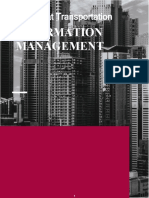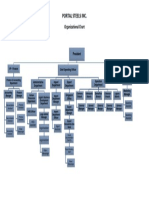0 ratings0% found this document useful (0 votes)
4 viewsSmart Transport System
A Smart Transport System (STS) integrates advanced technologies and real-time data to enhance the efficiency, safety, and sustainability of transportation networks. Key components include intelligent traffic management, connected vehicles, public transport integration, and sustainable transport solutions. While STS offers significant benefits such as reduced congestion and improved safety, challenges like high initial investment and privacy concerns must be addressed for successful implementation.
Uploaded by
Royal civilCopyright
© © All Rights Reserved
Available Formats
Download as DOCX, PDF, TXT or read online on Scribd
0 ratings0% found this document useful (0 votes)
4 viewsSmart Transport System
A Smart Transport System (STS) integrates advanced technologies and real-time data to enhance the efficiency, safety, and sustainability of transportation networks. Key components include intelligent traffic management, connected vehicles, public transport integration, and sustainable transport solutions. While STS offers significant benefits such as reduced congestion and improved safety, challenges like high initial investment and privacy concerns must be addressed for successful implementation.
Uploaded by
Royal civilCopyright
© © All Rights Reserved
Available Formats
Download as DOCX, PDF, TXT or read online on Scribd
You are on page 1/ 8
SMART TRANSPORT SYSTEM
Prepared by :
1. 24102293-ARUN PRASATH
2. 24102311-VIYASAN B
705, KNPC, TRICHY
Contact no: 9443797762
9361317678
Overview of Smart Transport Systems (STS):
A Smart Transport System (STS) integrates advanced technologies, real-time
data, and communication networks to improve the efficiency, safety, sustainability,
and overall performance of transportation infrastructure and services. The goal of
STS is to create a seamless, intelligent transportation network that optimizes traffic
flow, reduces congestion, enhances public transportation, and minimizes
environmental impacts.
Key elements of an STS include:
1. Intelligent Traffic Management: Automated traffic control, congestion
detection, and dynamic signal adjustments to optimize traffic flow and
reduce bottlenecks.
2. Connected and Autonomous Vehicles: Vehicles equipped with
communication technologies that interact with each other and infrastructure
to improve safety and route efficiency.
3. Public Transport Integration: Real-time tracking, smart ticketing, and
enhanced passenger information to improve the convenience and reliability
of public transit systems.
4. Sustainable Transport: Promotion of eco-friendly transportation methods
like electric vehicles, bike-sharing, and carpooling to reduce emissions and
fuel consumption.
5. Data Analytics and AI: The use of big data, machine learning, and
optimization algorithms to predict and manage traffic conditions, enhance
planning, and improve overall system efficiency.
6. Smart Parking Solutions: Technologies that guide drivers to available
parking spots, optimize parking space usage, and support dynamic pricing
for parking fees.
7. Environmental Monitoring: Integration of sensors and systems that track
air quality and other environmental factors to help cities develop sustainable
transport policies.
By enhancing connectivity, communication, and resource management, Smart
Transport Systems offer the potential for improved urban mobility, reduced
environmental impact, and better overall quality of life for citizens. However,
challenges such as infrastructure costs, data privacy concerns, and public
acceptance must be addressed for successful implementation.
In summary, STS represents a transformative approach to transportation, offering
smart solutions for today’s complex mobility challenges while paving the way for
sustainable, efficient, and safer urban transportation networks.
A Smart Transport System (STS) refers to the integration of advanced
technologies, data analytics, and communication systems to optimize the
efficiency, safety, and sustainability of transportation networks. It utilizes a variety
of tools and techniques to improve the management and operation of transportation
infrastructure, vehicles, and traffic flow. The ultimate goal of an STS is to create a
more efficient, convenient, and eco-friendly transport environment for individuals
and goods.
Key Components of a Smart Transport System:
1. Intelligent Traffic Management:
o Traffic Signal Control: Smart systems can dynamically adjust traffic
light timings based on real-time traffic conditions to reduce
congestion and improve traffic flow.
o Congestion Detection: Using sensors, cameras, and data analysis,
smart systems can monitor traffic patterns, identify bottlenecks, and
reroute traffic to alleviate congestion.
o Incident Detection and Management: Smart systems can detect
accidents, road closures, or other incidents in real time, enabling
quicker response times and better traffic management.
2. Connected Vehicles:
o Vehicle-to-Vehicle (V2V) and Vehicle-to-Infrastructure (V2I)
Communication: Vehicles communicate with each other and with
infrastructure (such as traffic lights and road signs) to share real-time
information. This can improve safety (e.g., collision avoidance) and
provide smoother travel by optimizing speed and routing.
o Autonomous Vehicles: Self-driving cars are a key part of smart
transport systems. They use sensors, GPS, and AI to navigate roads,
detect obstacles, and communicate with other vehicles or
infrastructure for improved safety and efficiency.
3. Public Transport Integration:
o Real-Time Tracking: Buses, trains, trams, and other forms of public
transport can be tracked in real-time, allowing passengers to access
accurate information about schedules and delays.
o Smart Ticketing: Electronic or mobile-based ticketing solutions
allow for seamless payment and boarding, eliminating the need for
cash transactions or paper tickets.
o Passenger Information Systems: Public transportation systems can
provide real-time information about schedules, delays, and route
changes, improving passenger experience and increasing ridership.
4. Sustainable Transport:
o Electric Vehicles (EVs): Electric cars, buses, and charging stations
are integrated into smart transport systems to reduce emissions and
reliance on fossil fuels.
o Bike-Sharing and Carpooling: Many smart systems integrate
alternative transportation methods, like bike-sharing programs or ride-
sharing services, to promote sustainability and reduce traffic
congestion.
o Low Emission Zones: Smart systems can monitor air quality and
vehicle emissions, implementing policies like low-emission zones that
restrict access to high-pollution vehicles.
5. Data Analytics and Artificial Intelligence:
o Big Data: Real-time data from sensors, GPS devices, social media,
and other sources is collected and analyzed to gain insights into
transportation patterns, peak traffic times, and infrastructure needs.
o Predictive Analytics: Machine learning and AI algorithms analyze
historical data to predict future traffic conditions, enabling more
effective route planning and demand forecasting.
o Optimization Algorithms: AI-driven systems can optimize traffic
flow, public transportation schedules, and routing to improve
efficiency, reduce travel time, and minimize fuel consumption.
6. Smart Parking Systems:
o Parking Sensors: Smart parking systems use sensors to detect
available parking spaces and guide drivers to them, reducing time
spent searching for parking.
o Dynamic Pricing: Parking fees can be adjusted dynamically based on
demand, encouraging the efficient use of parking resources and
promoting sustainable travel options.
7. Environmental Monitoring:
o Air Quality Sensors: Integrated systems can monitor pollution levels,
providing data on air quality and supporting the creation of policies
that reduce emissions and protect public health.
o Green Infrastructure: Incorporating green elements like green roofs,
solar panels, and rainwater harvesting into transportation
infrastructure can reduce the environmental impact of transport
networks.
Benefits of Smart Transport Systems:
1. Reduced Traffic Congestion: Intelligent traffic management and optimized
routes can help alleviate traffic jams, leading to smoother commutes and less
wasted time.
2. Improved Safety: Real-time incident detection, vehicle communication, and
autonomous vehicle technologies can significantly reduce accidents and
improve road safety.
3. Energy Efficiency: By optimizing travel routes, reducing idle times, and
promoting electric vehicles, smart transport systems can lower energy
consumption and reduce carbon footprints.
4. Cost Savings: Efficient use of infrastructure and resources, including
reduced fuel consumption and maintenance costs, can result in significant
savings for both individuals and cities.
5. Enhanced Public Transport Experience: Real-time tracking, seamless
ticketing, and optimized schedules make public transportation more
convenient, attractive, and reliable.
6. Environmental Sustainability: The integration of sustainable transport
modes (e.g., EVs, bike-sharing) and green infrastructure helps reduce the
environmental impact of transportation networks.
Challenges in Implementing Smart Transport Systems:
1. High Initial Investment: The infrastructure required to support smart
transport systems (e.g., sensors, data centers, communication networks)
requires significant upfront investment.
2. Privacy Concerns: The collection of real-time data on vehicles and
individuals raises concerns about data privacy and security.
3. Integration with Existing Infrastructure: Upgrading or integrating smart
technologies into older transportation systems and infrastructure can be
complex and costly.
4. Technological Standards: The lack of uniform standards across devices
and systems can create challenges in interoperability and compatibility.
5. Public Acceptance: The adoption of new technologies, such as autonomous
vehicles and smart ticketing, may face resistance from the public due to
concerns over reliability, safety, and job displacement.
Conclusion:
A Smart Transport System offers a promising solution to many of the challenges
faced by modern transportation networks, including congestion, pollution, and
safety concerns. By leveraging technologies like AI, IoT, and big data, smart
systems can optimize traffic flow, improve efficiency, and promote sustainability.
However, successful implementation requires overcoming challenges related to
investment, privacy, and integration with existing infrastructure. When deployed
effectively, STS can significantly enhance the overall transportation experience
and contribute to more sustainable and livable cities.
You might also like
- Urban Move - Open Innovation Challenge - ThemesNo ratings yetUrban Move - Open Innovation Challenge - Themes5 pages
- A Seminar On Intelligent Transport SystemNo ratings yetA Seminar On Intelligent Transport System15 pages
- Module 5-ITS,4th Half-3rd Internal NotesNo ratings yetModule 5-ITS,4th Half-3rd Internal Notes29 pages
- Smart Technology For Public Transportation SystemNo ratings yetSmart Technology For Public Transportation System4 pages
- The Integration of Smart Technologies in Highway Infrastructure Enhancing Safety, Efficiency, and SustNo ratings yetThe Integration of Smart Technologies in Highway Infrastructure Enhancing Safety, Efficiency, and Sust91 pages
- The Future of Transportation - Towards Sustainable and Autonomous MobilityNo ratings yetThe Future of Transportation - Towards Sustainable and Autonomous Mobility3 pages
- Optimization of Urban Road Traffic in Intelligent Transport SystemsNo ratings yetOptimization of Urban Road Traffic in Intelligent Transport Systems6 pages
- Intelligent Transport Systems Action Plan - Key Questions and AnswersNo ratings yetIntelligent Transport Systems Action Plan - Key Questions and Answers5 pages
- Advanced Traffic Management and Road Safety ReportNo ratings yetAdvanced Traffic Management and Road Safety Report3 pages
- A Smart City Project Is An Initiative Aimed at Developing AnNo ratings yetA Smart City Project Is An Initiative Aimed at Developing An3 pages
- Intelligent Transportation Systems: By: Ahmed Nabil AwaadNo ratings yetIntelligent Transportation Systems: By: Ahmed Nabil Awaad28 pages
- ITS in Australia: An Overview: What Are Intelligent Transport Systems (ITS) ?No ratings yetITS in Australia: An Overview: What Are Intelligent Transport Systems (ITS) ?18 pages
- Technologies in Transport and Energy SectorsNo ratings yetTechnologies in Transport and Energy Sectors8 pages
- A Survey On Intelligent Transportation System Using Internet of ThingsNo ratings yetA Survey On Intelligent Transportation System Using Internet of Things10 pages
- Chapter 1: Introduction: Smart Traffic Controlling SystemNo ratings yetChapter 1: Introduction: Smart Traffic Controlling System41 pages
- Contributions of women and students in the freedom movement for separate homeland for Muslims of British IndiaNo ratings yetContributions of women and students in the freedom movement for separate homeland for Muslims of British India2 pages
- Date Financial Assets Held For Trading: ILLUSTRATION 1: Initial MeasurementNo ratings yetDate Financial Assets Held For Trading: ILLUSTRATION 1: Initial Measurement2 pages
- Get Class 8 Civics Chapter 6 Confronting Marginalisation Notes FREE PDFNo ratings yetGet Class 8 Civics Chapter 6 Confronting Marginalisation Notes FREE PDF4 pages
- Cosentin@arts - Ucla.edu: Wac 134: Oral Traditions in AfricaNo ratings yetCosentin@arts - Ucla.edu: Wac 134: Oral Traditions in Africa5 pages
- Pengaruh Aset Pajak Tangguhan Dan Beban Pajak Tangguhan Pada Manajemen LabaNo ratings yetPengaruh Aset Pajak Tangguhan Dan Beban Pajak Tangguhan Pada Manajemen Laba3 pages
- CAPM Proof That Market Portfolio Is Value WeightedNo ratings yetCAPM Proof That Market Portfolio Is Value Weighted3 pages
- (Ebook) The Kingdom of Matthias : A Story of Sex and Salvation in 19th-Century America by Paul E. Johnson, Sean Wilentz ISBN 9780199892495, 9780199917594, 0199892490, 0199917590 all chapter instant download100% (4)(Ebook) The Kingdom of Matthias : A Story of Sex and Salvation in 19th-Century America by Paul E. Johnson, Sean Wilentz ISBN 9780199892495, 9780199917594, 0199892490, 0199917590 all chapter instant download71 pages
- Strategic Perspective For The Corps of Signals0% (1)Strategic Perspective For The Corps of Signals36 pages
- ADS-B FDL-DB Dual Band Series Installation Information: Document No. 88552100% (1)ADS-B FDL-DB Dual Band Series Installation Information: Document No. 88552129 pages
- Press Release Competitive Examinations 2024No ratings yetPress Release Competitive Examinations 20248 pages
- The Integration of Smart Technologies in Highway Infrastructure Enhancing Safety, Efficiency, and SustThe Integration of Smart Technologies in Highway Infrastructure Enhancing Safety, Efficiency, and Sust
- The Future of Transportation - Towards Sustainable and Autonomous MobilityThe Future of Transportation - Towards Sustainable and Autonomous Mobility
- Optimization of Urban Road Traffic in Intelligent Transport SystemsOptimization of Urban Road Traffic in Intelligent Transport Systems
- Intelligent Transport Systems Action Plan - Key Questions and AnswersIntelligent Transport Systems Action Plan - Key Questions and Answers
- Advanced Traffic Management and Road Safety ReportAdvanced Traffic Management and Road Safety Report
- A Smart City Project Is An Initiative Aimed at Developing AnA Smart City Project Is An Initiative Aimed at Developing An
- Intelligent Transportation Systems: By: Ahmed Nabil AwaadIntelligent Transportation Systems: By: Ahmed Nabil Awaad
- ITS in Australia: An Overview: What Are Intelligent Transport Systems (ITS) ?ITS in Australia: An Overview: What Are Intelligent Transport Systems (ITS) ?
- A Survey On Intelligent Transportation System Using Internet of ThingsA Survey On Intelligent Transportation System Using Internet of Things
- Chapter 1: Introduction: Smart Traffic Controlling SystemChapter 1: Introduction: Smart Traffic Controlling System
- Contributions of women and students in the freedom movement for separate homeland for Muslims of British IndiaContributions of women and students in the freedom movement for separate homeland for Muslims of British India
- Date Financial Assets Held For Trading: ILLUSTRATION 1: Initial MeasurementDate Financial Assets Held For Trading: ILLUSTRATION 1: Initial Measurement
- Get Class 8 Civics Chapter 6 Confronting Marginalisation Notes FREE PDFGet Class 8 Civics Chapter 6 Confronting Marginalisation Notes FREE PDF
- Cosentin@arts - Ucla.edu: Wac 134: Oral Traditions in AfricaCosentin@arts - Ucla.edu: Wac 134: Oral Traditions in Africa
- Pengaruh Aset Pajak Tangguhan Dan Beban Pajak Tangguhan Pada Manajemen LabaPengaruh Aset Pajak Tangguhan Dan Beban Pajak Tangguhan Pada Manajemen Laba
- CAPM Proof That Market Portfolio Is Value WeightedCAPM Proof That Market Portfolio Is Value Weighted
- (Ebook) The Kingdom of Matthias : A Story of Sex and Salvation in 19th-Century America by Paul E. Johnson, Sean Wilentz ISBN 9780199892495, 9780199917594, 0199892490, 0199917590 all chapter instant download(Ebook) The Kingdom of Matthias : A Story of Sex and Salvation in 19th-Century America by Paul E. Johnson, Sean Wilentz ISBN 9780199892495, 9780199917594, 0199892490, 0199917590 all chapter instant download
- ADS-B FDL-DB Dual Band Series Installation Information: Document No. 88552ADS-B FDL-DB Dual Band Series Installation Information: Document No. 88552

























































































